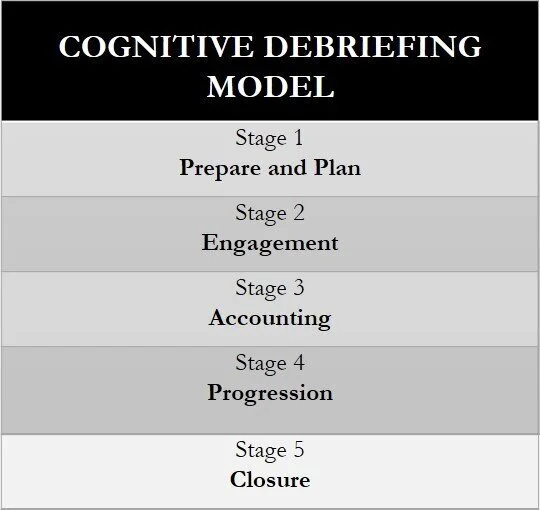Cognitive Debriefing Model - Debriefing Human Sources [Confidential Informants]
A model is a representation of a concept, created to aid the understanding of it. It is a simplified description of more complex ideas. When it comes to explaining how a Handler should debrief a source, there is a lot is going on, and a lot to remember especially when in an operational environment. It can be difficult to take it all in. The model is designed to help us remember what we have to do. However, by their nature models omit detail. The model we should use attempts take in as many of the factors at play as possible. This model is intended to guide us through the debrief of a source.
This model has five stages and there are 22 steps in it. This is an indication of the complexity of the task that is being undertaken. Debriefing a source is not about having a chat. It involves a combination of complex psychology, interpersonal skills, and field-craft. In naming the model we have considered several factors. First the ‘cognitive’ element of what we are trying to achieve; the word cognitive meaning connected with thinking or conscious mental processes. Second, many of the elements used are drawn from the cognitive interview. Third, there are distinct differences between interviewing and debriefing. The name makes it clear it is not interviewing. The model is called the ‘Cognitive Debriefing Model’
The 5 Stage Cognitive Debriefing Model
The 5 Stages of Cognitive Debriefing Explained
Stage one involves the preparation and planning before the debrief. Stage two, engagement, involves the initial contact with the source at the meeting location. Stage three is when we access the information that the source has stored in their memory, using techniques drawn from cognitive interviewing. Stage four is about discussing with the source how to progress with what has been learned and what further tasks the source should undertake. Stage five is about ending the debriefing on a positive note. It is about strengthening the relationship and ensuring the safety of all involved, as they go their separate ways. A full description of all the steps is included in the book Human Sources - Managing Confidential Informants
In using this model, we refer to the source recalling ‘events’. We can think of an event in a similar way that we would consider an episode of our favorite television series. Events may take place over a prolonged period or come in rapid succession. A source may have met their associates the previous week, and then again, the previous evening. This would be considered as two events. However, in the case where a source meets first with two associates and they then drive to a bar where a third associate joins them, these may also be considered as two events each must be separately examined.
Handlers must enter the debriefing process in a friendly non-combative way. It is not an interrogation. It is not about forcing the source to give up information. If it is, the Handlers have failed to properly recognize and address the source’s motives for giving information. The priority should be to first address this problem and only then seek information. If the source’s motives are not being addressed there is every chance they will lie, misdirect, and deceive the Handler, in whatever way they can. Time is then wasted trying to sort the wheat from the chaff, only to find that the wheat that is there, is full of weevils.

